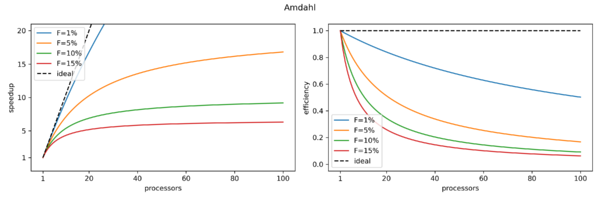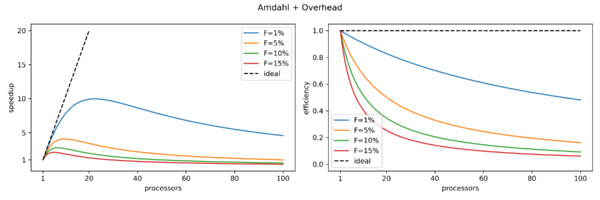Difference between revisions of "Benchmarking & Scaling Tutorial/Introduction"
| Line 1: | Line 1: | ||
{{DISPLAYTITLE:Introduction & Theory}}<nowiki /> | {{DISPLAYTITLE:Introduction & Theory}}<nowiki /> | ||
{{Syllabus Benchmarking & Scaling}}<nowiki /> | {{Syllabus Benchmarking & Scaling}}<nowiki /> | ||
| + | |||
__TOC__ | __TOC__ | ||
== Scalability == | == Scalability == | ||
| Line 7: | Line 8: | ||
| − | == | + | == Strong Scaling == |
| + | |||
| + | === Amdahl's Law === | ||
We assume that the total execution time <math>T</math> of a program is comprised of | We assume that the total execution time <math>T</math> of a program is comprised of | ||
* <math>t_s</math>, a part of the code which can only run in serial | * <math>t_s</math>, a part of the code which can only run in serial | ||
| Line 39: | Line 42: | ||
| − | === | + | ==== Speedup and Efficiency ==== |
Knowing that <math>t_o > 0</math>, and writing <math>F = \frac{t_s}{t_s + t_p}</math> as the fraction of the serial code, we can rewrite this to | Knowing that <math>t_o > 0</math>, and writing <math>F = \frac{t_s}{t_s + t_p}</math> as the fraction of the serial code, we can rewrite this to | ||
| Line 65: | Line 68: | ||
[[File:amdahl.png|600px]] | [[File:amdahl.png|600px]] | ||
[[File:amdahl_overhead.png|600px]] | [[File:amdahl_overhead.png|600px]] | ||
| + | |||
| + | == Weak Scaling == | ||
| + | === Gustafson's Law === | ||
| + | ==== Speedup and Efficiency ==== | ||
| + | === Consequences === | ||
| + | |||
Knowing about speedup and efficiency we can now try to measure this ourselves. | Knowing about speedup and efficiency we can now try to measure this ourselves. | ||
Revision as of 12:40, 24 September 2021
| Tutorial | |
|---|---|
| Title: | Benchmarking & Scaling |
| Provider: | HPC.NRW
|
| Contact: | tutorials@hpc.nrw |
| Type: | Online |
| Topic Area: | Performance Analysis |
| License: | CC-BY-SA |
| Syllabus
| |
| 1. Introduction & Theory | |
| 2. Interactive Manual Benchmarking | |
| 3. Automated Benchmarking using a Job Script | |
| 4. Automated Benchmarking using JUBE | |
| 5. Plotting & Interpreting Results | |
Scalability
Often users who start running applications on an HPC system tend to assume the more resources (compute nodes / cores) they use, the faster their code will run (i.e. they expect a linear behaviour). Unfortunately this is not the case for the majority of applications. How fast a program runs with different amounts of resources is referred to as scalability. For parallel programs a limiting factor is defined by Amdahl's law. It takes into account the fact, that a certain amount of work of your code is done in parallel but the speedup is ultimately limited by the sequential part of the program.
Strong Scaling
Amdahl's Law
We assume that the total execution time of a program is comprised of
- , a part of the code which can only run in serial
- , a part of the code which can be parallelized
- , parallel overheads due to, e.g. communication
The execution time of a serial code would then be
The time for a parallel code, where the work would be perfectly divided by processors, would be given by
is the speed up amount of time due to the usage of multiple CPUs. The total speedup is defined as the ratio of the sequential to the parallel runtime:
The efficiency is the speedup per processor, i.e.
Speedup and Efficiency
Knowing that , and writing as the fraction of the serial code, we can rewrite this to
This places an upper limit on the strong scalability i.e. how quickly can we solve a problem of fixed size by increasing . It is known as Amdahl's Law.
Consequences
- The speedup is never linear in P, therefore the efficiency is never 100%
- Examples:
- For P=2 processors, to achieve E=0.9, you have to parallelize 89% of the code
- For P=10 processors, to achieve E=0.9, you have to parallelize 99% of the code
- For P=10 processors, to achieve E=0.5, you have to parallelize 89% of the code
Weak Scaling
Gustafson's Law
Speedup and Efficiency
Consequences
Knowing about speedup and efficiency we can now try to measure this ourselves.
Next: Interactive Manual Benchmarking
Previous: Overview

















